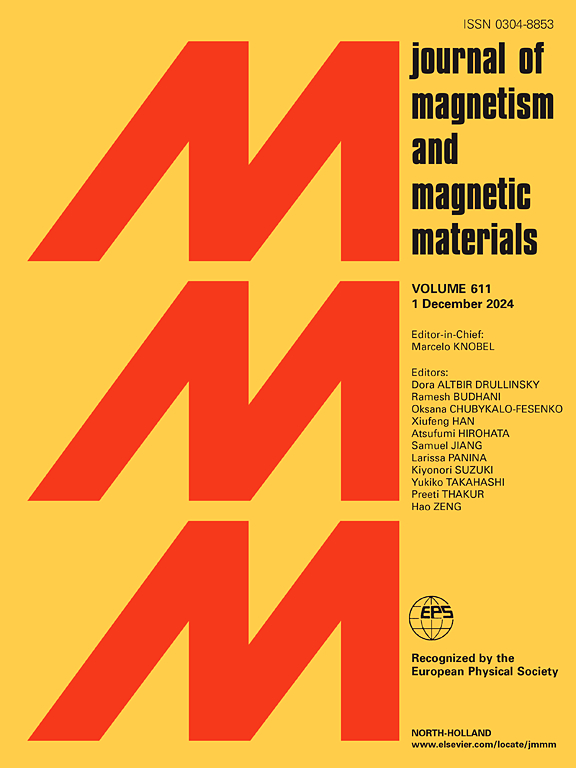Experimental estimation of the remanent induction for the study of functional fatigue in permanent magnets
IF 2.5
3区 材料科学
Q3 MATERIALS SCIENCE, MULTIDISCIPLINARY
引用次数: 0
Abstract
The magnetization of new generation hard ferromagnetic materials is difficult to access experimentally without the use of advanced and expensive instruments. This article proposes two novel, easily implementable techniques for measuring the remanent induction of permanent magnets: a variant of the extraction method and a residual magnetic field method. Both methods are validated on hard Ferrites by comparison with hysteresis loop measurements taken as a reference measurement. The advantages and disadvantages of each method are discussed. Subsequently, the proposed techniques are applied to measure the remanent induction of rare-earth magnets, specifically Neodymium–Iron–Boron (Nd![]() Fe
Fe![]() B) and Samarium-Cobalt (Sm-Co). The obtained results exhibit consistency with manufacturer-provided data, attesting to the accuracy of the proposed measurement methodologies. Furthermore, the research investigates the effect of cyclic mechanical loading on the remanent induction of permanent magnets. The magnets are subjected to a set of 106 sinusoidal uniaxial compression cycles at a frequency of 30 Hz and at stress amplitudes representative for practical conditions in electrical machine applications. The remanent induction of the mechanically cycled magnets is subsequently measured. The investigation reveals no significant fatigue effect on the remanent induction in the studied hard materials. Overall, this study provides insights into the magneto-mechanical coupling effects in hard ferromagnetic materials and into the performance analysis of magnet properties under time-varying mechanical loadings.
B) and Samarium-Cobalt (Sm-Co). The obtained results exhibit consistency with manufacturer-provided data, attesting to the accuracy of the proposed measurement methodologies. Furthermore, the research investigates the effect of cyclic mechanical loading on the remanent induction of permanent magnets. The magnets are subjected to a set of 106 sinusoidal uniaxial compression cycles at a frequency of 30 Hz and at stress amplitudes representative for practical conditions in electrical machine applications. The remanent induction of the mechanically cycled magnets is subsequently measured. The investigation reveals no significant fatigue effect on the remanent induction in the studied hard materials. Overall, this study provides insights into the magneto-mechanical coupling effects in hard ferromagnetic materials and into the performance analysis of magnet properties under time-varying mechanical loadings.
求助全文
约1分钟内获得全文
求助全文
来源期刊

Journal of Magnetism and Magnetic Materials
物理-材料科学:综合
CiteScore
5.30
自引率
11.10%
发文量
1149
审稿时长
59 days
期刊介绍:
The Journal of Magnetism and Magnetic Materials provides an important forum for the disclosure and discussion of original contributions covering the whole spectrum of topics, from basic magnetism to the technology and applications of magnetic materials. The journal encourages greater interaction between the basic and applied sub-disciplines of magnetism with comprehensive review articles, in addition to full-length contributions. In addition, other categories of contributions are welcome, including Critical Focused issues, Current Perspectives and Outreach to the General Public.
Main Categories:
Full-length articles:
Technically original research documents that report results of value to the communities that comprise the journal audience. The link between chemical, structural and microstructural properties on the one hand and magnetic properties on the other hand are encouraged.
In addition to general topics covering all areas of magnetism and magnetic materials, the full-length articles also include three sub-sections, focusing on Nanomagnetism, Spintronics and Applications.
The sub-section on Nanomagnetism contains articles on magnetic nanoparticles, nanowires, thin films, 2D materials and other nanoscale magnetic materials and their applications.
The sub-section on Spintronics contains articles on magnetoresistance, magnetoimpedance, magneto-optical phenomena, Micro-Electro-Mechanical Systems (MEMS), and other topics related to spin current control and magneto-transport phenomena. The sub-section on Applications display papers that focus on applications of magnetic materials. The applications need to show a connection to magnetism.
Review articles:
Review articles organize, clarify, and summarize existing major works in the areas covered by the Journal and provide comprehensive citations to the full spectrum of relevant literature.
 求助内容:
求助内容: 应助结果提醒方式:
应助结果提醒方式:


